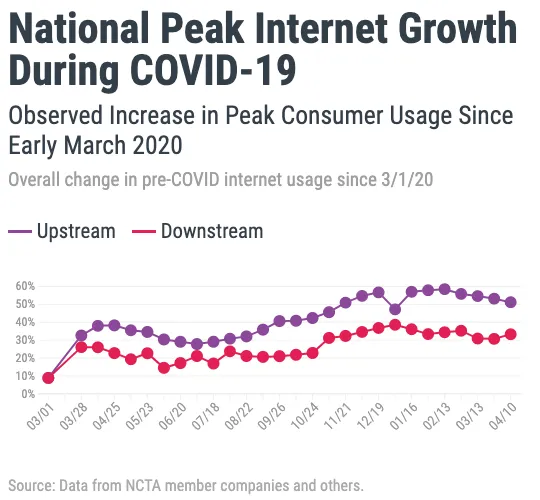A new report by the expert Broadband Internet Technical Advisory Group (BITAG), a multi-stakeholder organization composed of engineers and technologists from various sectors across the internet ecosystem, highlights how the internet rose to the challenge of huge traffic surges during the pandemic and continues to perform well as millions of Americans continue to learn and work from home.
The report, “2020 Pandemic Network Performance,” co-edited by NCTA Vice President of Broadband Technology Matt Tooley and DISH Network Senior Engineering Program Manager Kate Landow, examines from a holistic view the data available on internet traffic patterns and network performance and asserts that the internet’s resiliency is a “testament to the importance of continued investment in robust internet infrastructure in all parts of the ecosystem … “
Since the onset of the COVID-19 pandemic in March 2020, NCTA has been collecting and reporting network performance data from America’s leading internet service providers (ISPs) through the NCTA COVID-19 Internet Dashboard. The dashboard continues to reveal that cable broadband networks have been a reliable infrastructure that met the biggest stress test ever imagined. The new BITAG report further supports these findings and delves deeper into how the increased demand affected the internet and how organizations, such as ISPs, responded in turn.
A few of the report’s highlights include the following:
- ISPs observed significant growth in downstream and upstream traffic up to 40% during peak business hours and as much as 60% in some markets.
- Traffic ratios between downstream and upstream traffic shifted slightly due to greater upstream consumption as a result of a spike in videoconferencing usage, although traffic ratios remained strongly asymmetric because downstream traffic continued to far outpace upstream traffic.
- Videoconferencing traffic, albeit a small portion of overall traffic, increased substantially with some networks observing up to a 300% increase in traffic, while applications including gaming, web access and video streaming also saw substantial increases.
- ISPs augmented capacity to keep pace with the significant increases in internet traffic and user demands on various applications and services.
- Home Wi-Fi networks with customer supplied home gateways and/or Wi-Fi access points experienced performance challenges often due to the combined effects of increased traffic demand, a larger number of connected devices, and outdated devices and home network equipment.
In reference to the last point on home Wi-Fi networks, the report recommends that internet users experiencing performance issues examine their home networks, particularly their devices and Wi-Fi equipment, because many times poor performance was found to be linked to outdated equipment in need of upgrades.
BITAG’s overall findings indicate that the American internet was and continues to be a success story during a difficult time. Millions of Americans had quick and smooth transitions to working and learning from home in terms of connectivity. As BITAG states, “If [the internet] had collapsed there would have been numerous reports of internet users having trouble getting online, slow page loads, aborted or failed videoconferencing sessions, streaming video quality issues, and other issues. Nor did we find any data that supports that there were widespread issues.” ISPs jumped into action when the shift-to-home caused a surge in internet traffic in a short period of time, and thanks to their significant investment in their broadband networks over the past couple of decades, Americans found a way to continue a semblance of their lives online.

To check the latest findings on nationwide network performance during the pandemic, go to the NCTA COVID-19 dashboard.








